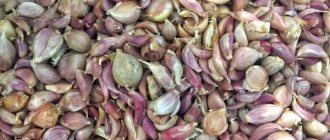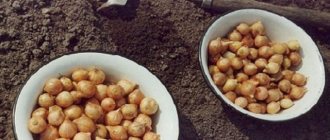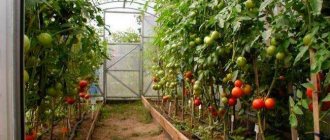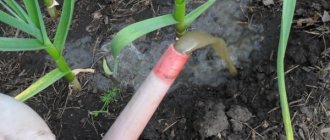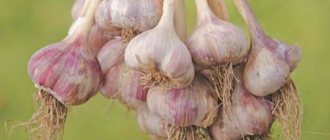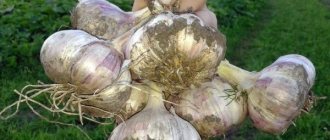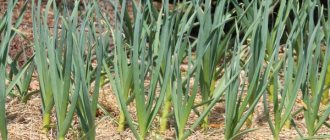Garlic is a type of onion; it can be grown either in winter or spring. ( discussion of the features of growing vegetable crops
)
| Light | Garlic is light-loving and prefers open, dry, sunny beds. |
| Ph soil acidity | Garlic grows well in loamy soils rich in organic matter with a pH of 6.5-7.0. Acidic soils need to be limed . |
| Watering garlic | With a lack of moisture, the garlic feather acquires a bluish-white tint, and its tip bends. With excess moisture, the feather turns pale green. After planting, it is watered once a week in May-June (5-10 liters per 1 m²); in July, watering is reduced, because The bulbs are ripening, but if there is a drought, watering is acceptable to prevent wilting. |
| Preparing for landing | Preparation of the bed for planting winter garlic begins in August (1-1.5 months before planting). For 1 m² of loamy soil, add 1 bucket of organic fertilizer, 1 tablespoon of superphosphate and potassium sulfate, lime the bed and dig it to a depth of 18-20 cm. After this, the bed is leveled and spilled with a solution of copper sulfate (1 tablespoon per 10 liters of water ) at the rate of 1 liter of solution per 1 m² of bed. The bed is covered with film before planting the garlic. Before planting, garlic cloves are sorted by size and soaked in a solution of table salt (3 tablespoons of salt per 5 liters of water) for 2 minutes. Then the cloves are placed for 1 minute in a solution of copper sulfate (1 teaspoon of sulfate per 10 liters of water), after which they are washed with water and planted in the beds. It is not always economically profitable to grow garlic from cloves, so the best plants are noted in advance, on which arrows with inflorescences are specially left; after the “wrapper” on them bursts and the bulbs acquire a characteristic color, the plant is completely pulled out of the soil and dried. Before sowing, the largest healthy bulbs are selected, dried and planted in the beds. |
| Fertilizers | Fertilizers are applied for autumn digging (per 1 m²): 3 kg organics (compost, humus), 1 tablespoon each of superphosphate, nitrophoska, wood ash . In the spring, the prepared bed is leveled, spilled with a solution of copper sulfate (1 tablespoon per 10 liters of water), liquid consumption - 2 liters per 1 m², and the bed is covered with black film for 2-3 days. If the growth of leaves is slow, you can feed the garlic: for 10 liters of water, 1 cup of mullein or bird droppings, 1 tablespoon of urea. Solution consumption - 3 liters per 1 m². After 15 days, fertilizing can be repeated. The third feeding is carried out when the bulbs become the size of a walnut. |
| Good predecessors | Good predecessors for garlic are green manure, pumpkin, cabbage, beans, and peas. |
| Bad Predecessors | Predecessors cannot be onions, garlic, cucumbers, carrots. |
| Garlic planting time | Winter garlic is planted 35-45 days before frost (September 20 - October 10). During this time, the teeth should take root, but not extend their arrows. Garlic bulbs are planted at the same time. |
| Garlic planting scheme | Scheme for planting winter garlic from bulb bulbs - 2x10 cm. Scheme for planting winter garlic from cloves - 7x25 cm. |
| Planting depth | To plant winter garlic, you can use fresh cloves or bulbs. If winter garlic is grown from bulbs, the depth of planting the bulbs is 2-3 cm. The bed can be mulch . Garlic cloves are embedded in the soil to a depth of 6-8 cm (from the surface of the soil to the top of the clove there should be 4-5 cm). |
| Problems | When the feather reaches a height of 15 cm, you can carry out preventive treatment against fungal diseases : 1 teaspoon of copper sulfate and 1 tablespoon of liquid soap are diluted in 10 liters of water. Leaves are sprayed with the solution (0.5 l per 1 m²). Diseases and pests of garlic : neck rot, downy mildew, onion rust, black mold, fusarium, stem nematode, onion fly. Many plants in joint plantings are able to take care of their neighbors and protect their. |
| Care and cultivation | Caring for garlic involves timely watering and weeding . Garlic beds are loosened once every 2 weeks to a depth of 3 cm. |
| Garlic varieties | Varieties of winter garlic: Gribovsky 60, Gribovsky Jubilee, Danilovsky local, Komsomolets, Otradnensky, Poretsky local. |
| Harvesting garlic | Garlic is ready for harvesting when the formation of new feathers has stopped, when the feather has died down, and the heads have formed and acquired a characteristic color. Garlic is harvested from mid-August to the first ten days of September. If harvesting is late, the garlic will resume growth, break into slices and become unsuitable for storage. |
Garlic is planted in the second half of September - early October. The time must be calculated so that approximately a month and a half remains before the onset of stable winter cold. Then the garlic will have time to take root well, but will not germinate before the first snow.
Winter garlic prefers sandy loam soils. The beds for it are prepared in advance, a week and a half before planting. The soil is dug to a depth of 25 cm, weeds are carefully removed, 5-6 kg of humus (but not fresh manure!), 30 g of superphosphate, 20 g of potassium salt per 1 square meter are added. m. A day or two before planting, add ammonium nitrate at the rate of 10-12 g per 1 sq. m. m. Dry soil is watered.
Before planting, several cloves need to be “stripped” and inspected: cloves with signs of rot, mold, or numerous yellow spots (bacterial spotting) are unsuitable for planting. Garlic should be well dried; if damp, it will quickly begin to grow.
To protect garlic from diseases, it can be soaked for 2-3 hours in a warm solution of pink potassium permanganate. More effective disinfection: 3 minutes in a solution of table salt (1 tablespoon per 2 liters of water), then 3 minutes in a solution of copper sulfate (1 teaspoon per 2 liters of water).
The largest cloves from the largest bulbs are selected for planting. The analysis is carried out immediately before planting - otherwise the bottom of the clove, on which the roots form, will dry out. The old mother bottom must be removed, as it will act as a plug.
Rows on a well-leveled bed are placed at a distance of 20-25 cm, leaving 10-12 cm between plants. Can be planted in furrows. The main thing is not to press the teeth into the ground, this will delay the growth of roots. In addition, compacted soil can then push the garlic to the surface and it will freeze. But the soil should not be too loose (you need to lightly compact it with a board), because then the cloves can “drown” and the bulbs will turn out small and will not be stored well.
Planting depth depends on soil type and clove size. There should be 3-4 cm from its top to the soil surface. Planting too shallowly threatens freezing. Plantings should be mulched with a layer of peat, humus or sawdust 2-5 cm thick, and brushwood should be spread out to retain snow on the beds. In the spring, the mulch layer is removed to prevent the plants from rotting.
Care is quite traditional: systematic loosening, removal of weeds. Watering is necessary during active growth (otherwise a large head will not form), but is not necessary during the ripening period of the bulbs.
If necessary, fertilize: in early spring - with urea (1 tablespoon per 10 liters of water) and another one or two in the summer. You can use slurry, bird droppings, diluted 12-15 times. Feed (and water) garlic only at the root. If the leaves become too light, it means that it needs to be fed with a nitrophoska solution (2 tablespoons per bucket of water).
When the shoots of the shooting garlic grow to 10 cm, they should be removed, otherwise you can’t count on a good harvest. Several strong plants can be left for breeding and the bulblets can be allowed to mature.
Shortly before harvesting, the soil from the bulbs is raked - this promotes the ripening of garlic. And they remove it when the lower leaves turn yellow, in late July - early August. By the way, winter garlic ripens better than spring garlic. The scales become dense and durable. You shouldn’t overexpose garlic in the garden: the bulb will begin to disintegrate into cloves, germinate and will not be stored well.
There is a cold way to store garlic (in a dry room at a temperature of 0-3 ° C) and a warm way - at room temperature.
This culture has its own characteristics. It is important to observe the timing of planting and harvesting garlic. The plant is returned to its place after 3-4 years. You should not grow garlic after onions. Legumes, pumpkin, cabbage and green crops are considered good predecessors for it.
Planting garlic
The root system of the plant is quite weak. Due to the fact that it develops in the top layer of soil, it is best to plant in a fertile area. The soil must be well cultivated.
Medium and large sized bulbs are most suitable for growing garlic. Before planting the garlic, the heads need to be divided into cloves. Medium to large sized cloves are suitable for planting. If the head contains only 2-3 teeth, they will not fit. These are degenerating heads. If plants reproduce for a long time only by teeth, then they accumulate harmful substances. Every 3-4 years it is necessary to update all planting material.
All damaged teeth are discarded. To make plants less susceptible to diseases, scales should not be removed from them.
Winter varieties of garlic are planted in the fall. In the second half of September or early October. The soil temperature at this time is 12-15°C. The time should be calculated so that stable cold weather arrives in about a month and a half. Do not be afraid that the cold will harm the plantings. The main thing is that the root system has time to develop. It is an important condition for obtaining a high-quality and rich harvest. Predecessors must vacate the bed no later than the end of July. Plantings will develop well if fertilizers are generously applied to their predecessors. Do not plant crops on fresh manure. This will lead to the development of diseases and pests.
When planting garlic before winter, you need to till the soil well. In a week and a half, the sandy loam soil is dug up and all weeds are removed.
In the spring, in April, spring varieties of garlic are planted. If you first keep the cloves in the refrigerator for 2-3 weeks, you can reap a good harvest.
When planting in spring, the depth is on average 6 cm. When planting in autumn, it is 8 cm. The distance between large cloves is 6-8 cm. Between the middle ones, the distance should be 4-6 cm. When planting, there is no need to press on the cloves. This will make it difficult for roots to germinate. In addition, the soil can push the cloves upward and they will freeze. The soil should be worked, dug, but not loose. It needs to be compacted a little. Plantings are mulched with sawdust, peat or humus. In spring, the mulch layer is removed.
Preparation of planting material
Separating the cloves from the garlic base is carried out 1-2 days before planting. For planting, only healthy, large garlic is selected, without damage to its integrity and characteristic of this variety. When separating and selecting cloves from four cloves (garlic with only four cloves in the head), they are all suitable for planting. If there are a lot of cloves in the head, then only the outer cloves are taken for planting, and the inner ones are used for culinary purposes.
If you use your own material for planting, and last season there was yellowing of the tips of the leaves, then the planting material must be treated with a solution of copper sulfate. To do this, you need to dilute a tablespoon of copper sulfate in one liter of water, and sprinkle the teeth with this solution. Let the cloves dry and then begin planting.
Such treatment of planting material with a copper-containing preparation will destroy fungal spores both on the cloves and in the earthen coma adjacent to the garlic. You can use other fungicidal agents to treat garlic.
Cultivation care
It is good to feed the plantings with mineral and organic fertilizers. In the fall, add compost and humus. There is no need to use fresh manure. Nitrogen fertilizers accelerate the growth of vegetative mass and also reduce yields. Winter varieties respond well to potash and phosphorus fertilizers. The first time they are fed with mineral fertilizers is when seedlings appear. The second time after 25-30 days. It is better to use superphosphate, ammonium nitrate and potassium sulfate.
It is necessary to protect plantings from fuarium (bottom rot). This disease is dangerous not only because it reduces the amount of harvest, but also makes the product dangerous to human and animal health. The plant is also affected by siemphiliasis, peronosporosis, black neck rot, rust, and white rot. During storage, the crop may become covered with black and green mold.
The most common pests of this crop are: onion flies, onion thrips, onion secretive proboscis, onion moths, nematodes, hoverflies, and root mites.
The use of garlic peels for the vegetable garden or garden
Garlic peel is widely used in the fight against vegetable and garden pests, as well as for protection during winter storage of crops.
Practical examples of its use:
- Sprinkling husks over stored root crops prevents them from rotting and becoming infected;
- adding to a whitewash solution for fruit trees;
- decoctions and tinctures of onion and garlic peels are used to combat aphids, mites, Colorado potato beetles, weevils on strawberries, caterpillars on cabbage, carrot flies and other garden pests;
- adding it to holes when planting potatoes, tomatoes and vegetables repels Colorado potato beetles and wireworms;
- To reduce scab on the leaves of berry bushes during the ripening period, the husks are poured into the root circle.
Therefore, after harvesting a rich harvest of garlic and throughout the winter, as the heads are consumed for food, the husks should be collected and placed in fabric bags to be used beneficially in the next gardening season.
Watering garlic
Plantings do not tolerate excessive waterlogging. But they need regular watering. Abundant watering is carried out with a break of 7-10 days. The plants are watered and fed for the first time in early May. A month before harvesting, watering garlic should be stopped.
Why is it important to harvest garlic on time?
It is best to harvest 5 days earlier than a day or two later. When harvested early, the bulbs retain their nutrients and have a good presentation. Their scales remain intact. If the garlic harvesting time is delayed, the bulbs crack, crumble, and become loose. Thus, they lose their presentation and become unsuitable for long-term storage.
Garlic harvesting time and winter garlic harvesting time
Shooting varieties are harvested when the lower leaves turn yellow and the shells on the inflorescences crack. The best time to harvest winter garlic is when the lower leaves turn yellow and the false stem softens. Usually this is the end of July and the beginning of August. The harvest date for spring garlic is two weeks later. Shortly before harvesting, the soil should be rake away from the bulbs - this way they will ripen better. If the summer is rainy, the harvest is carried out earlier.
A perennial plant like garlic belongs to the onion family. Its flowering time falls in the months of July and August. The culture is popular all over the world: its pungent taste and characteristic specific smell are known to almost everyone.
Ridge formation
As a rule, garlic is grown using the strip method, planted in 5 rows with a 20 cm distance between rows. However, recently the Mittleider method has become especially popular. This technology involves the formation of narrow raised ridges - 10-20 cm in height and 30-45 cm in width. They are well warmed up by the spring sun, protected from gusts of wind and soil erosion due to the presence of high sides, and are less susceptible to overgrowing by weeds.
There are two ways to prepare a Mitlider bed for garlic.
- Using boxes-beds. To do this, boxes are assembled from boards, which are then installed on the site and filled with fertile substrate.
- Using earthen ramparts. To do this, mark the beds and walkways directly on the site - 40 and 100 cm wide, respectively. Form mounds between them, check the beds for no height differences.
Magical and so simple garlic
The king of spices is what Pythagoras called this plant.
About 5 thousand years ago, garlic appeared in Rome and Ancient Greece. Its main use then was medicinal - it was boiled in water, used for disinfection and to heal wounds. Along with opium, it was one of the main medicines. Before the operation, the patient drank a decoction of garlic, and also soaked wound dressings with it. This was done so that the pain would be relieved and the blood would not become infected.
And the ancients were sure that it would help strengthen the spirit and strength, and cure all diseases. What is the superiority of spring (or spring) garlic? How, where and when to plant it?
How does imported garlic behave?
Garlic is a plant that reproduces vegetatively. Its new generations will demand the same environmental conditions in which they themselves were formed. Therefore, its range is narrow. This will mean that if you bring garlic from other places, it will not grow well in the new place. The yield of garlic brought to a new place will greatly decrease, diseases and pests will attack it more often. And he may gradually die.
Many gardeners are wondering how to plant garlic in the spring. Since spring garlic, although not frost-resistant, is cold-resistant, some experienced agronomists who grow large quantities of garlic for sale put it in white bags for the winter (the kind in which sugar is sold), and bury one and a half shovels deep in the ground. Cover with a large layer of leaves on top and insulate with film. Under such a fur coat he does not freeze, but feels comfortable. If a summer resident plants a small amount of garlic, then it can be placed in the refrigerator for a couple of weeks before planting. Some people keep garlic for about half an hour in a weak solution of potassium permanganate or saline solution (3 tablespoons per half bucket of water) before planting.
When, where and how to plant garlic in spring
Garlic is planted immediately after frost, around mid-April. The land where garlic or onions were planted before is not suitable for planting garlic, and the land after potatoes is also not suitable. It is better if cucumbers, zucchini, early white cabbage, and cauliflower grow there before the garlic. The beds should be dug up and loosened.
Immediately before planting, you should water the soil generously with a solution of table salt, at the rate of 3 tbsp. spoons into a bucket of water. Plant garlic bottom down. Approximately 1-2 centimeters deep. The distance between the cloves is 8-10 centimeters, and the distance between the beds is 15 centimeters. After germination, it is advisable to feed the garlic with ammonium sulfate, which prevents pests from spoiling the harvest. It is advisable to repeat this procedure in mid-June.
Garlic loves moisture very much, but you shouldn’t overwater it in July. Let it dry a little before collecting.
Selecting a location
Preparing beds for winter garlic begins with choosing a good location. To grow large heads of garlic, rich in useful components, you need to choose the right place for planting.
The area where you plan to plant garlic should be well lit and protected from draft winds. It is better to choose a hill. If you choose a lowland, then after the snow melts, moisture will accumulate in the area, which contributes to the rotting of the heads. Large trees should not grow nearby or there should be a solid fence - this will prevent sunlight from penetrating into the vegetable beds. The soil should be loose, light and fertile. Loamy composition with a normal acidity level is well suited
It is important to know what to fertilize the soil on the site before planting garlic.
The spicy vegetable grows slowly and develops in the shade, in low-lying places, as well as on land where there is constant accumulation of water. The best choice is the place where the snow falls first, and in the spring it takes a long time to melt.
What conditions are needed for the normal development of garlic?
Garlic is a cold-resistant crop. At temperatures below 1 degree, roots already begin to grow. But the optimal temperature for growth is 8-12 degrees. The above-ground part of the plant begins to grow at temperatures from 5 to 10 degrees above zero.
At the beginning of its growth, vigorous garlic needs slightly above-zero temperatures. Otherwise, the above-ground part may begin to grow strongly, and the formation of the bulb will not be successful. Therefore, the sooner you plant fervent garlic, the better it will be. During the period when garlic cloves begin to take root, they need moisture. If it is not enough, then the root system will dull its growth.
